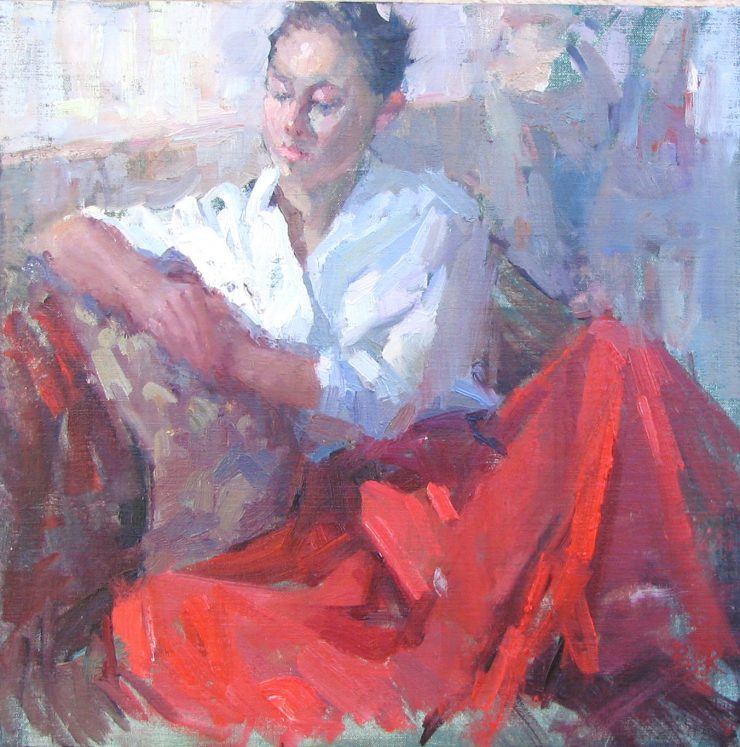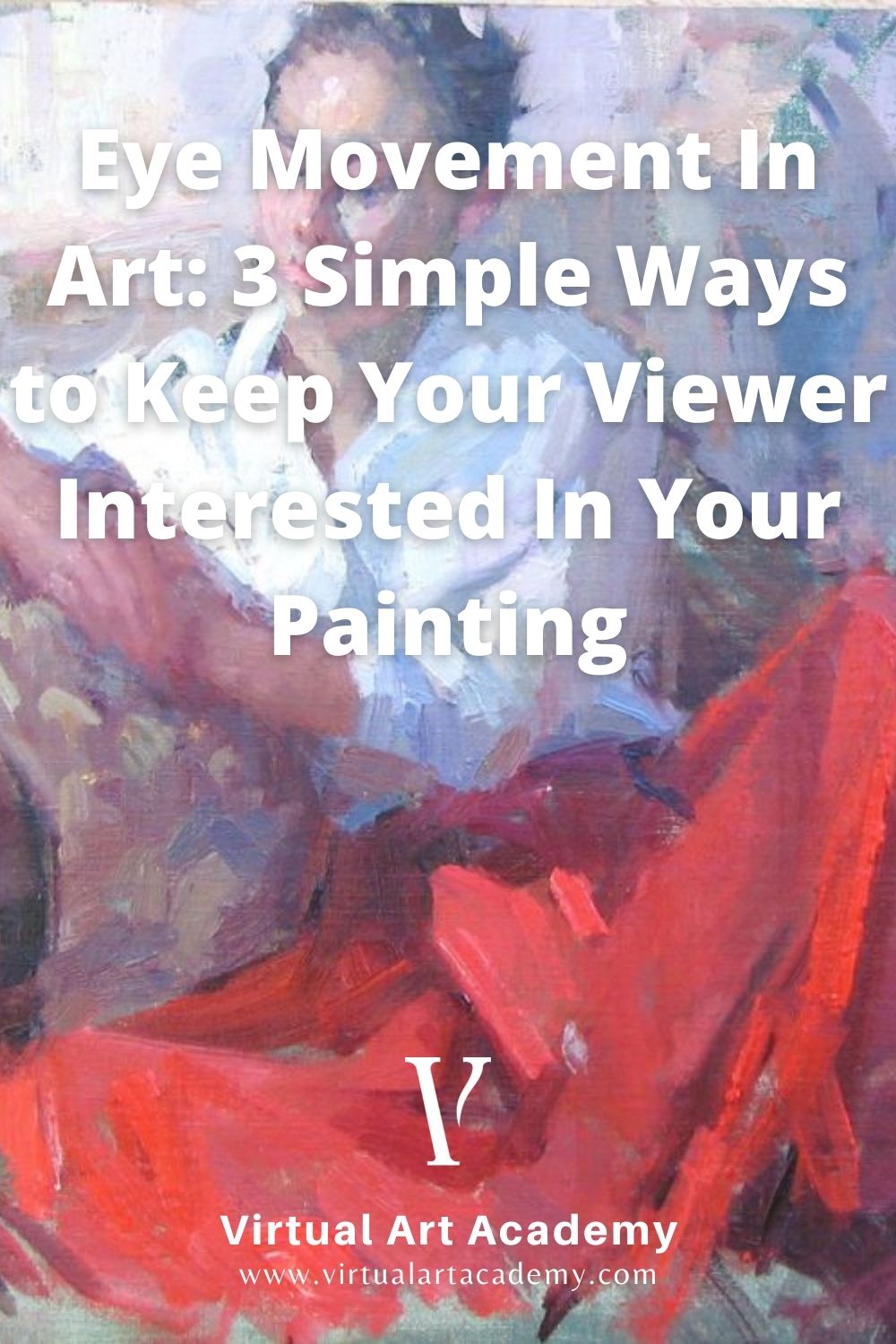
(Get free painting tips and plein air painting techniques sent straight to your inbox or on my social media.)
The longer a viewer is drawn to look at your painting, the more eye movement in art you can create, the more interesting that painting is to them. One measure of the quality of a painting is how long you can keep the viewer looking at it, by encouraging eye movement in your artwork.
Your goal is to keep the viewer’s interest by keeping their eye movement all over your artwork, while at the same time preventing the eye leaving the painting, or getting trapped in one spot. Getting viewers to be interested in your art is not easy, but here are a few simple ways you can promote visual interest through eye movement.
How do I create eye movement in art?
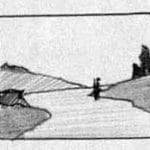
One of the easiest ways to create eye movement in art, is to provide a pathway in the composition for the eye to follow.
The pathway can be created using:
- color
- brushwork and visual lines
- patterns of lights and darks
How can I use color to create eye movement in art?
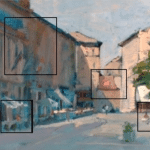
The easiest way of creating eye movement in art is to repeat a specific color throughout the canvas. The viewer’s eye bounces from one color spot to another in the painting, and in the process ends up looking at all of the painting surface.
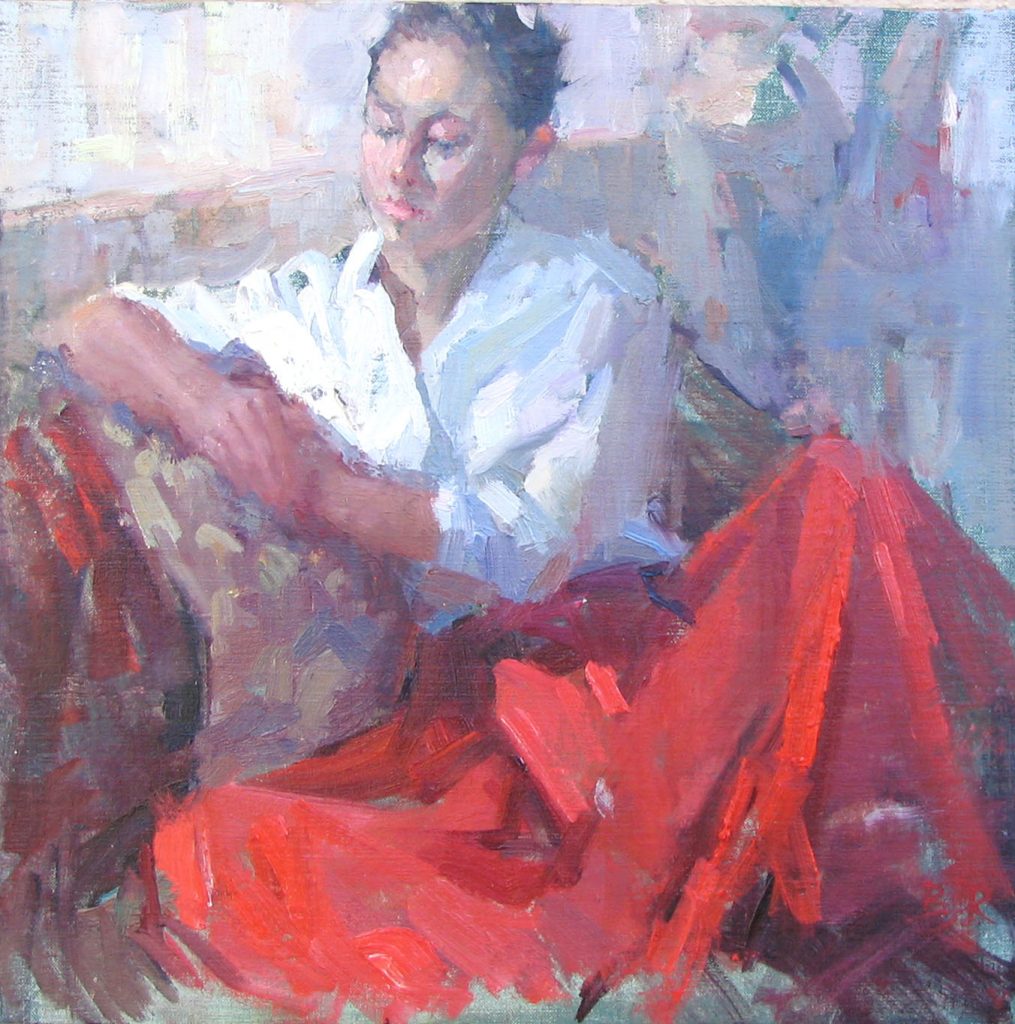
In the painting of Maya I used the color red to make the eye movement bounce around the painting.
- The folds of the skirt are painted in saturated color to direct the eye.
- The red in the pattern of the chair is picked out.
- Red color spots are repeated in the features, particularly in the lips and ear.
- There are red brushstrokes in the background.
- Even the signature, in cadmium red light, becomes part of the design.
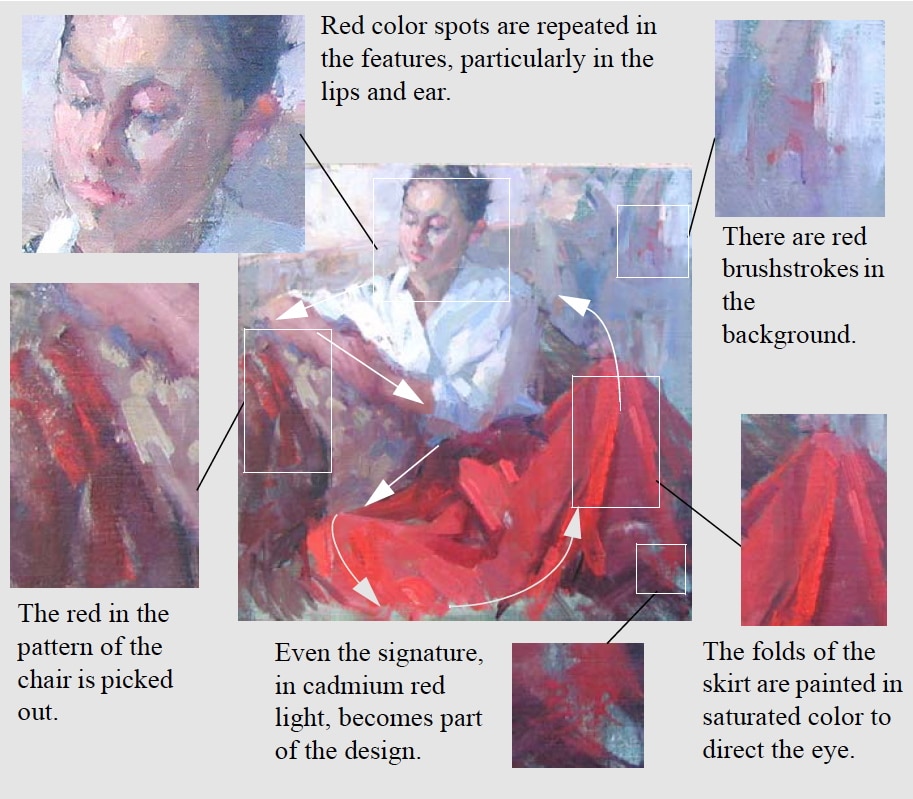
How can I use brushwork to create eye movement in art?
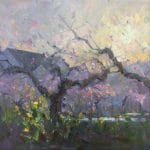
A method of increasing eye movement in art is to use your brushwork to reinforce the composition and direct the eye where you want it to land. You can add a perspective line, such as a path moving into the distance, or the graceful curve of a tree.
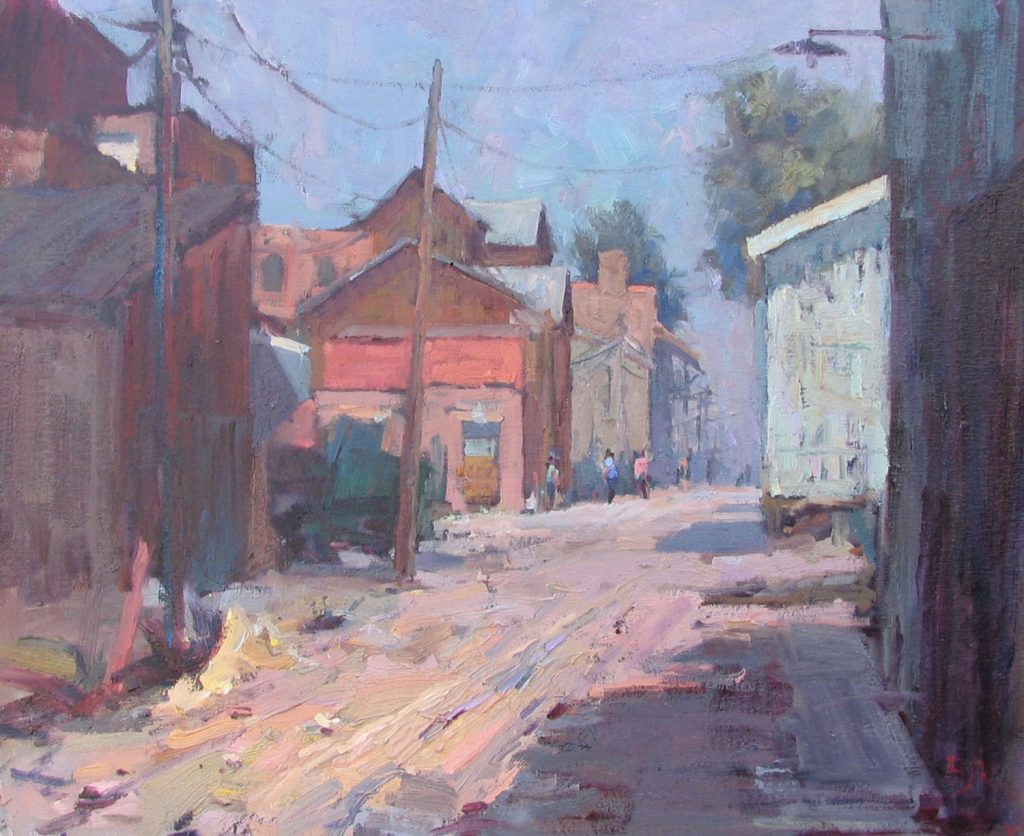
In this painting you can see how I used long, thick brushstrokes in the foreground to lead the eye movement into the painting and toward the focal area.
How can I use lights and darks to create eye movement?
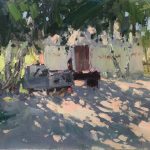
Sprinkle dark and/or very light areas around your painting to promote eye movement in art and keep your painting interesting.
For example, if you sprinkle areas of darks and lights in your painting, it encourages the eye to jump from one to the other so they notice more things in your composition.
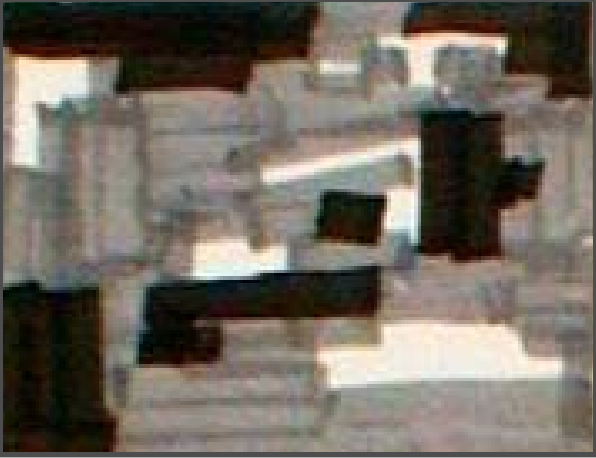
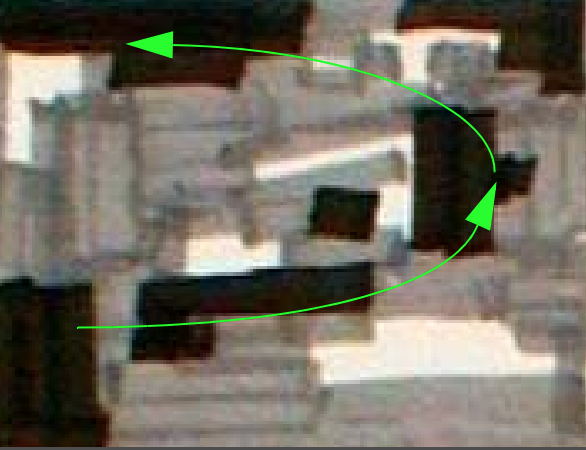
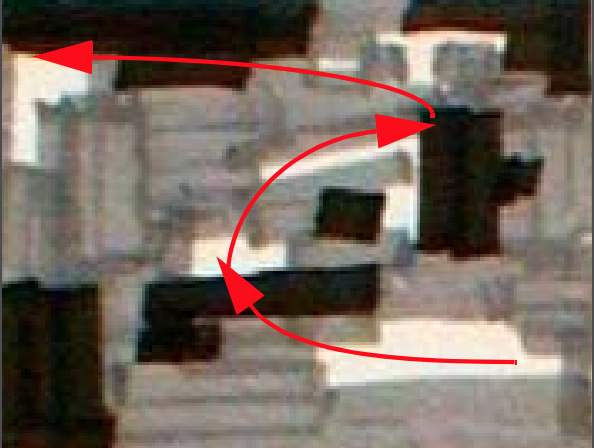
The darks lead your
eye along a path, in this case a
reversed ‘C’.
The lights lead your eye in a
reversed ‘S’.
In this painting of the flowers in my garden, I used areas of light paint on top of a darker background, to keep the eye movement flowing around the art. This is a principle in notan design called spotting. If you squint at the picture, which reduces the design of the painting to a simpler black and white pattern, you can see more clearly this underlying notan design. At its simplest, it consists of two values – a middle gray and a series of light shapes.
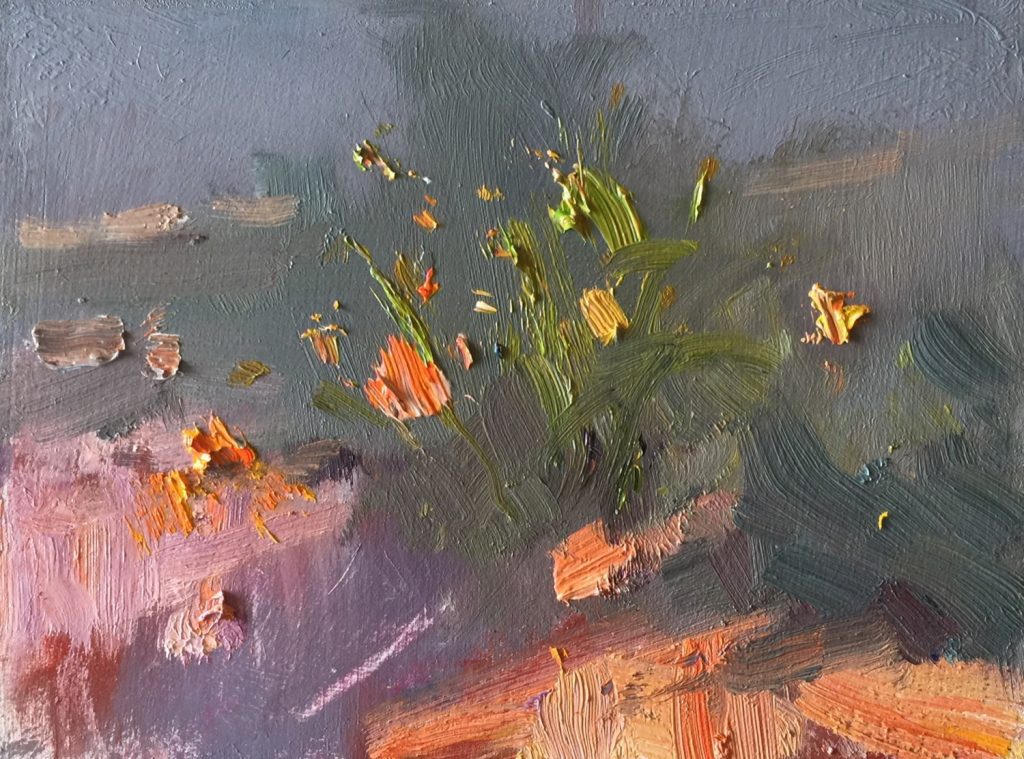
Saccades
In reality, the movement of the eye around a scene such as a painting is far more complex than this. The pattern of eye movement described in many art books is overly simplified, if not actually not true. What really happens is that both eyes move in a series of quick, simultaneous movements between phases of fixation in the same direction on a particular part of the scene.
Humans and many other animals do not look at a scene in a steady way; instead, the eyes move around, finding interesting parts of the scene and building up a three-dimensional ‘mental map’ of the scene.
When scanning a painting, human eyes make these saccadic movements and stop several times, moving quickly between each pause. The eyes move as fast as they are able between the stops, and this speed cannot be controlled.
One reason for the saccadic movement of the human eye is that the central part of the retina—known as the fovea—which provides the high-resolution and color part of vision is very small in humans. The central area is only about 1–2 degrees of vision, but is very important for recognizing objects. Using this type of movement, the eyes can scan small but important parts of a scene more efficiently and with greater resolution.
Typically the eyes will fixate on parts of the scene that hold greater significance for humans. For example an image of a human. This is quite difficult to predict, but can now be measured using certain specialized devices for tracking eye movements.
Thank You
Thank you for taking the time to read this article. I hope you find it useful. If you would like to get free painting tips by email, please sign up for my free tips newsletter.
If you are interested in a structured approach for learning how to paint, take a look at my online painting classes.
Happy painting!
Barry John Raybould
Virtual Art Academy
What The Students Are Saying
Fantastic lesson plans, and a vibrant community
The Virtual Art Academy is the perfect art course I’ve been searching for. Barry’s decades of knowledge are condensed into fantastic lesson plans, creating a vibrant community. The apprentice course delves deep into drawing, painting planning, and color theory. It’s like obtaining an art degree at my own pace and more affordably. The structured format encourages interaction and feedback, enhancing the learning experience. Overall, a fulfilling way to study art from home.
Building blocks of learning is the best I have seen

Read more “Building blocks of learning is the best I have seen”
This is a far more superior school than anything I have seen being taught at colleges across the country

It is wild to see how much I am learning in this course!

I retired last year, and decided I wanted to spend my time in retirement learning how to oil paint. But having never painted before, I wasn’t even sure what to look for in an online painting course. However, I did some searches for “Best Online Oil Painting Courses,” and found several references to VAA.
I signed up for VAA’s ongoing Apprentice Program last October (2023), and I am incredibly glad I did! As a beginner, I didn’t know what I didn’t know, but I didn’t have to: VAA has already mapped it all out for me. It starts out with basic, fundamental stuff, but also teaches me the THINKING that goes in the painting: the composition, my color choices, how to consciously select which darks and lights need to be emphasized, etc.
Bottomline, I am learning how to create paintings that have both visual music and poetry, and it is super fun to see my growth! I cannot recommend this course enough!
Read more “It is wild to see how much I am learning in this course!”
comprehensive art education

It is a real course that trains you in a structured way

Read more “It is a real course that trains you in a structured way”
No need to buy expensive art books…. Just do the VAA 4 year course. I still refer to it

Read more “No need to buy expensive art books…. Just do the VAA 4 year course. I still refer to it”
The most comprehensive, in depth and well-organized painting course available online

Read more “The most comprehensive, in depth and well-organized painting course available online”
Since I started the programme I can see improvements in my composition and use of colour

I have been working through the VAA course for over five years and would highly recommend it to anyone wanting to improve their painting. There is a huge amount of information on the site and it is well presented and regularly updated and added to. When other members have commented on work I have posted I have found it really useful. When I review my work over the time since I started the programme I can see improvements in my composition and use of colour.
Read more “Since I started the programme I can see improvements in my composition and use of colour”
The equivalent of a 4 year art education at a fraction of the cost

Read more “The equivalent of a 4 year art education at a fraction of the cost”
First quality education, materials, layered learning systems, feedback loop and social support and lifelong learning – amazing
Thank you again for such an amazing program and opportunity. I wish you continued and even greater success. You have contributed to many many people… thank you from all of us.
The course is for beginners, intermediate and advanced artists

Read more “The course is for beginners, intermediate and advanced artists”
The sky’s the limit

What I learned from 10 years with VAA

It does mean you have to look at things differently in the beginning but it is really exciting to learn a new, simpler way of painting- its all about VALUES!!!
It all seems a bit strange, making Notans, outline studies, value studies all in greys, colour maps, ie not painting a pretty picture in colour, but you must trust the experts and just do it. It’s all about being able to see the big shapes and values which takes, in my case, a long time for the brain to learn how to do. Once you see, it the lightbulb goes on and everything clicks into place.
Be patient, do the exercises, trust the process and you will get good results. I did as Barry suggested and just worked through the exercises in my sketchbook from life, I didn’t paint pictures for long time. I stayed on values studies for a very long time and found I was enjoying painting again.
It’s ok to take your time. Just keep working and try to find a routine for studying, keep at it. After a long time working like this I am now getting pictures into Art Societies in London (The Chelsea Art Society and the The Mall Galleries- RBA, NEAC and Pastel Society) selling them and even winning prizes. I’ve joined Plein Air groups in London and Surrey (which are free) met and made new friends and am part of a community of like-minded artists which is important to me and makes me happy.
Georgie Rey
https://www.artmajeur.com/georgina-rey
Barry gave me a fishing rod so I can catch my own fish

Read more “Barry gave me a fishing rod so I can catch my own fish”
The small steps are easy to do

It is impossible to fail or gain little through extensive 4 year study at VAA!
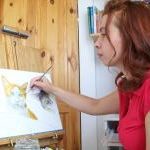
Read more “It is impossible to fail or gain little through extensive 4 year study at VAA!”
I’m Richard Robinson …. best online art training available on the internet today

In my opinion Barry has created the best online art training available. I found the Virtual Art Academy course of painting lessons many years ago and was so inspired by it that I contacted the author and got to know him personally.
Two Critical Keys
If you are looking (like I did) for the best painting course available there are two key things you should know about the Virtual Art Academy course which make it stand out above the other online painting courses available today:
1. It’s Comprehensive.
It covers ALL the key painting concepts and then goes further, revealing more and more painting insights. Most courses miss a LOT out – this one doesn’t.
2. It’s easy to understand.
All that information could easily become confusing, but each piece is laid out clearly and concisely using Information Mapping® making it a pleasure to learn.
If you can find another painting course which does these 2 things better, please let me know. As I said, I have been searching for many years and continue to do so, so you could save yourself a lot of precious time and money by joining the Virtual Art Academy today.
Read more “I’m Richard Robinson …. best online art training available on the internet today”
The improvement in my own work reaffirms that I’ve found the right program to develop as an artist

VAA, the ultimate art course
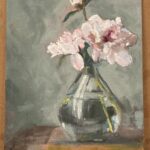
‘Ladder of Learning’ adds to overall positive experience of this awesome course

Read more “‘Ladder of Learning’ adds to overall positive experience of this awesome course”
The most comprehensive art instruction I could find anywhere online, and trust me, I had been looking for a long time.

The Virtual Art Academy is simply the most comprehensive art instruction I could find anywhere online, and trust me, I had been looking for a long time.
Even art schools and academies I’ve been exposed to are nowhere near as thorough, VAA is just amazing!
Most paintings I see where the artist clearly has some skill still lack in either the values or notan department, or fall down on composition – it’s baffling that VAA seems to be the only program that goes into detail on this. Therefore, if you are new to painting or an experienced artist, studying with VAA will get you to that next step.
I also find that Barry is always interested in what we students do and is at hand with great advice. Worth every penny, Thank you Barry!!
I started learning oil painting with VAA from scratch. Just one year later my paintings started to sell

The course has a steady learning curve that keeps revealing itself as you advance

Read more “The course has a steady learning curve that keeps revealing itself as you advance”
Only online learning program I have ever discovered using a training industry best practice

VAA is the only online learning program I have ever discovered using a training industry best practice of incorporating Knowledge and Skills to support learning a new activity. Every building block (Drawing, Form, Observation, Concept, Notan, Composition, Colour, Brushwork) incorporates a “spiral learning” approach where you are introduced to the Knowledge/Skill at one level and then reintroduced to it again elsewhere in the curriculum. Sure genius.
I’ve attended workshops, read books, and watched YouTube videos — and none of them provide the scaffolded approach to learning the VAA offers. If you are just starting your painting journey, start here. If you are a mid level or advanced painter, start here. There is a sense of community with artists around the globe. You are part of a peer to peer learning process bigger than yourself.
As a result of the VAA, I have been juried into several shows, am represented by a local gallery and have been selling my paintings on a consistent basis. VAA curriculum’s approach will grow your ‘artist’s brush’ and aid you in finding your artistic voice. As your basics improve, your art improves. Henry Hensche said, “There is study and there is performance, and we should not confuse the two, study is done for perceptual development, our performances show us where we are in that development, and we must have both…”. VAA curriculum offers both.
I went through the entire curriculum, did every every exercise, and today review my printed books/exercises on an annual basis to keep myself fresh and ready for my next painting adventure.
Onwards/Sideways,
Jay “jbird” Holobach
https://www.jayholobach.com/
A great learning platform

An excellent foundation on so many aspects of painting

When I got word of the course available through Virtual Art Academy, I was very excited for the opportunity to learn what I never knew about painting. VAA has provided me an excellent foundation on so many aspects of painting. The course is organized very logically, provides great examples, diagrams, thorough explanations and worthwhile assignments. I highly recommend this course to anyone with a desire for an in-depth education of art.
Thank you again, Barry, I love this course Jeanne
Read more “An excellent foundation on so many aspects of painting”
